

Online - Music Theory Online - Staffs, Clefs & Pitch Notation. Tonic Sol-fa In 1840s England, J.
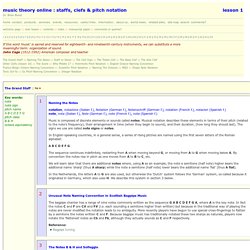
S. Curwen (1816-1880) introduced a system, earlier developed by Sarah Glover of Norwich (1785-1867) in her Scheme for Rendering Psalmody Congregational (1835), which was designed to help in the sight-reading of music. The system was called the Tonic Sol-fa method. Curwen's method later incorporated French time names (derived from Aime Paris's Langue de durées ) and devised pitch hand signs which, in a modified form, are familiar to contemporary music teachers as part of the popular Kodály method. What is Electro Swing? Electro Swing Explained in 2 minutes. Musikk. 01.04.2010 Gerhard’s Licktionary J It is important to have a bag of licks to play in various situations.
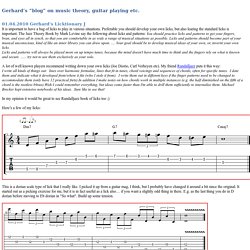
Preferable you should develop your own licks, but also learing the standard licks is important. The Jazz Theory Book by Mark Levine say the following about licks and patterns: You should practice licks and patterns to get your fingers, bran, and eyes all in synch, so that you are comfortable in as wide a range of musical situations as possible. Chord Explorations. Looking for a way to master chord voicings?

Howard Rees has a plan for you. Keyboard Magazine Article – March 2001 Everyone wants to get the most out of the limited amount of time they get to spend alone at the keyboard. At any point in your development as a keyboard player, there are dozens if not hundreds of different directions you could choose to explore. How do you decide which way to go to maximize that precious practice time? The more you understand about the relationships that musical elements have to one another, the easier it will be for you to spend your practice time learning the things that will be the most useful to you. For instance, I can remember a time when I didn’t know that a minor 7th chord could be thought of as occurring on the 5th degree of a dominant 7th scale.
To begin with, take a look at The Dominant Species (click the link) to get a basic understanding of where I think musical elements come from. Diminished Dimensions. By Howard Rees with Ernie Rideout Keyboard Magazine Article – April 2004 As creative improvisers, we’re thought of as being very free with our approach to music.
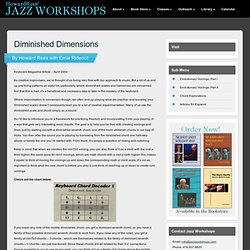
But a lot of us end up practicing patterns an awful lot, particularly where diminished scales and harmonies are concerned. Not that this is bad; it’s a beneficial and necessary step to take in the mastery of the keyboard. Where improvisation is concerned, though, we often end up playing what we practice, and knowing your diminished scales doesn’t necessarily lead you to a lot of creative experimentation. Music Theory: Intervals at Learn Music Free. An Interval in music refers to the distance between any two notes.

The types of Intervals are, Unison, Perfect, Major, Minor, Augmented and Diminished. Intervals are used in both Chords and Melody. In Chords, Intervals are the distance between each Chord tone. In Melody, Intervals are the distance (scale steps) from one note in the Melody to the next. Should You Practice Jazz With A Metronome? Should You Practice Jazz With A Metronome?
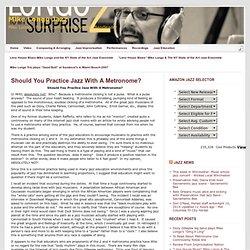
In MHO, absolutely not! Great Rhythm Exercise. David Liebman: Educational Articles. Go Back to Articles Index JAZZ RHYTHM by DAVID LIEBMAN What is Jazz Rythym When one listens to music what are the key elements that a listener responds to aside from the obvious factors of volume and intensity?
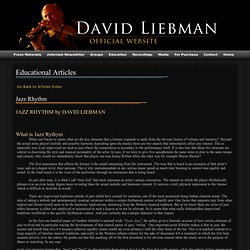
Beyond the actual notes played (melody and possibly harmony depending upon the music) there are two aspects that immediately affect any listener. This is especially true in an improvised art such as jazz where the composition is secondary to the performance itself. The first impression that affects the listener is the sound emanating from the instrument. Sans titre. AnalyseFilleCheveuxLin. Cours d'harmonie. Les Bases de l'Harmonie - Dareios. La première partie présente les intervalles, l'harmonisation des gammes et des mélodies, le travail de l'oreille et la construction des accords.
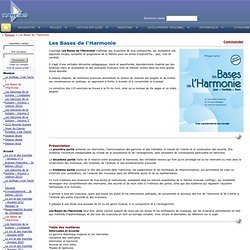
Elle constitue l'ouverture indispensable au monde de la composition et de l'arrangement, sans nécessiter de connaissance particulière en harmonie. La deuxième partie traite de la relation entre acoustique et harmonie, des véritables raisons qui font qu'on privilégie tel ou tel intervalle ou note dans la construction des morceaux, des tonalités, de l'analyse et des enchaînements d'accords. La troisième partie explique le rôle des accords dans l'harmonie, les substitutions et les techniques de réharmonisation, qui permettent de créer ou d'enrichir une composition, de l'analyse des morceaux dans les différents styles et de sa représentation.
Nicolas Slonimsky. Nicolas Slonimsky (April 27 [O.S.

April 15] 1894 – December 25, 1995), born Nikolai Leonidovich Slonimskiy (Russian: Никола́й Леони́дович Сло́нимский), was a Russian-born American conductor, author, pianist, composer and lexicographer. Best known for his writing and musical reference work, he wrote the Thesaurus of Scales and Melodic Patterns and the Lexicon of Musical Invective, and edited Baker's Biographical Dictionary of Musicians. Life and work[edit]